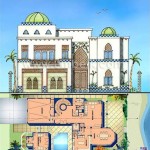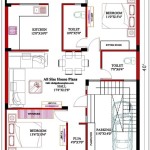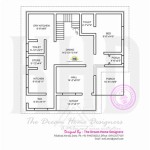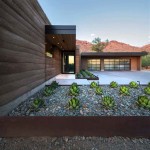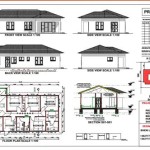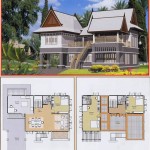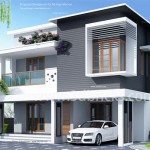Spanish House Plan: A Guide to Design and Features
Spanish house plans are characterized by their unique architectural style that blends European influences with the warm climate of Spain and Latin America. These homes are known for their distinctive features, aesthetic appeal, and comfortable living spaces. This article provides a comprehensive overview of Spanish house plans, exploring their key characteristics, design elements, and the factors to consider when planning a Spanish-style home.
Key Features of Spanish House Plans
Spanish house plans showcase a distinctive architectural style that sets them apart from other designs. Some of the most prominent features of these homes include:
- Stucco Exterior: The signature feature of Spanish architecture is the use of stucco for the exterior walls. Stucco is a plaster-like material that creates a smooth, textured finish and adds to the home's timeless appeal.
- Red Tile Roof: Spanish homes are often adorned with red tile roofs that complement the stucco exterior and evoke a sense of Mediterranean charm. The red tiles are durable, aesthetically pleasing, and help to regulate the temperature of the home.
- Arched Doorways and Windows: Arched doorways and windows are a prominent design element in Spanish architecture. These arches add a touch of elegance and create a sense of grandeur, often framing picturesque views of the surrounding landscape.
- Courtyard or Patio: Spanish houses often incorporate a central courtyard or patio, providing an outdoor space for relaxation and entertainment. The courtyard is typically surrounded by walls or columns and features lush greenery, fountains, or other decorative elements.
- Saltillo Tile Flooring: Saltillo tile flooring is a traditional feature of Spanish homes. This type of tile is made from clay and is known for its durability, rustic charm, and ability to complement the overall aesthetic of the house.
Design Elements in Spanish House Plans
Beyond the key features, Spanish house plans incorporate various design elements that contribute to their distinctive character. These elements include:
- Wrought Iron Accents: Spanish homes frequently feature wrought iron accents, such as balconies, railings, and gate designs. Wrought iron adds a touch of craftsmanship and artistry to the exterior and interior spaces.
- Terracotta Details: Terracotta, another traditional material, is commonly used in Spanish architecture for decorative elements such as pots, planters, and tile accents. Terracotta's earthy tone complements the stucco and tile, creating a cohesive and warm aesthetic.
- Colorful Tiles: Spanish house plans often incorporate colorful tiles in the interior and exterior spaces, adding bursts of vibrant color and personality. These tiles are frequently used on walls, floors, and countertops, creating a sense of vibrancy and eclectic charm.
- Decorative Beams and Ceilings: Exposed wood beams and ornate ceilings are common features of Spanish homes. These elements add a touch of warmth and rustic charm to the interior spaces while highlighting the architectural style.
- Natural Light: Spanish homes typically emphasize natural light by featuring large windows and open floor plans. The abundant natural light creates a sense of spaciousness and enhances the warmth and inviting atmosphere of the home.
Factors to Consider When Planning a Spanish-Style Home
While the aesthetic appeal of Spanish house plans is undeniable, it's essential to consider several factors when designing and building a Spanish-style home. These considerations include:
- Climate: Spanish homes are designed to adapt to warm climates. The red tile roofs help regulate the temperature, while the open floor plans allow for natural ventilation. If you are planning to build in a colder climate, you may need to make adjustments to ensure comfort throughout the year.
- Site and Landscape: Spanish house plans often work best on expansive lots with plenty of outdoor space. The central courtyard or patio is a key feature of the design, and the surrounding landscape should complement the overall aesthetic.
- Budget: Building a Spanish-style home can involve a significant investment, especially if you are using traditional materials like stucco, terracotta, and wrought iron. It's essential to create a realistic budget and explore cost-effective options while staying true to the design principles.
- Maintenance: Some design elements, such as stucco and tile, require specific maintenance practices. Research the upkeep requirements and factor them into your long-term plans.

Small Spanish Contemporary House Plan 61custom Modern Plans Style Homes

Spanish House Plan 1 Story Coastal Style Home Floor Mediterranean Plans New

Two Story Spanish House Plan 9724

Sonora Grove Spanish Mission House Plan Design 4 Bed 3 Bath 2940 Sq Ft Double Garage Drawings Blueprints

3 Bed Spanish Style House Plan With Front Courtyard 46072hc Architectural Designs Plans

Two Story Spanish Style House Plan With Exercise Nook In Master Bath 36596tx Architectural Designs Plans

Home Plan Gavello Sater Design Collection

Small Spanish Contemporary House Plan 61custom Modern Plans Style Homes Mediterranean

Villa Rivero Luxury Floor Plans Mediterranean

Spanish Revival Style Home 1926 Universal Plan Service No 543 House Plans Portland Homes

